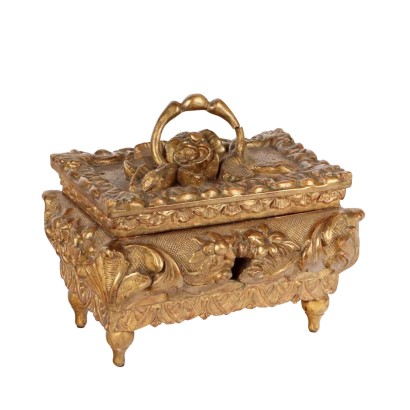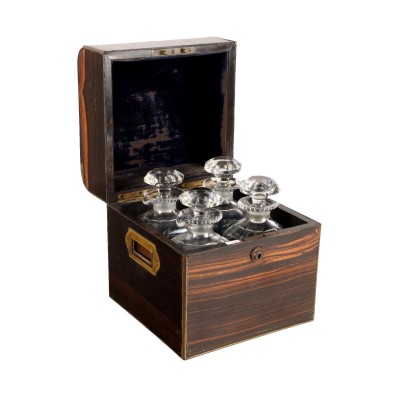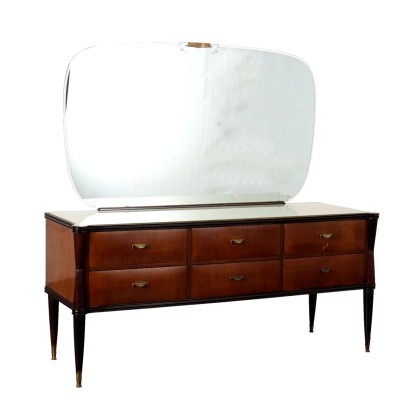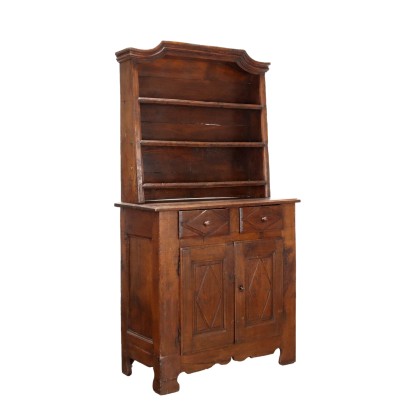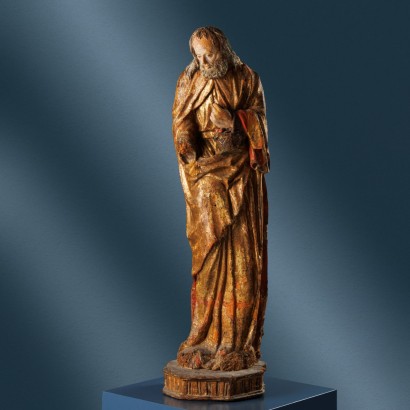Small Chest Late Renaissance Veneto Italy Early XVIII Century - Italy, Early XVII Century
Features
Italy, Early XVII Century
Style: Renaissance (1460-1630)
Age: 17th Century / 1601 - 1700 , 16th Century / 1501 - 1600 , 15th Century / 1401 - 1500
Origin: Alto Veneto, Italy
Main essence: Walnut
Material: Carved Wood
Description
Late Renaissance Alto-Veneto walnut box, Italy early 17th century. Top with perimetric fret pattern, decorated internal border, front carved with fret pattern, phytomorphic spirals and central coat of arms motif. Crosspieces under the top missing, hinges replaced, feet added later.
Product Condition:
Product that due to age and wear requires restoration and re-polishing. We try to present the real state of the furniture as fully as possible with photos. If some details are not clear from the photos, what is reported in the description will prevail.
Dimensions (cm):
Height: 19
Width: 41
Depth: 26
Additional Information
Style: Renaissance (1460-1630)
During the Renaissance, furniture took on architectural forms, perfect proportions, and was adorned with rationally arranged decorations, taken from Greco-Roman iconography.Supports and feet carved in the shape of an acanthus leaf or a lion's paw appeared at least from the early 1460s.
Alongside parallelepiped chests, others appeared in the shape of a classical sarcophagus, with surfaces marked by ornamental metrics rigidly disciplined within pilasters and frames.
The novelty of the sculptural carving decoration derived from archaeological remains triumphs, decoded and reworked stylistic elements in different compositional harmonies arranged in alternating games of dentils, ovules, volutes, acanthus-shaped spirals, loricature, strigliature, grotesque candelabras, and the entire pantheon of pagan mythology comes to life again, in particular to decorate chests, which from their initial function as containers for the wedding dowry take over the new instance of real parade furniture.
It is worth remembering that the displayed furniture was generally richly embellished with gold leaf gilding.
In the first decades of the sixteenth century the use of Certosina inlay definitively faded away, although even in the Renaissance this technique had great fame, just think of the activity of the Tasso workshop in Florence.
Learn more about the Renaissance style with our insights:
The Renaissance style
A pair of candle holders between the Renaissance and Baroque
FineArt: The Renaissance
FineArt: Renaissance Cassina gilded, Belloni family – Venice, 16th century
The dictionary of antiques - Savonarola
INSERT ADDITIONAL LINKS
The Austrian taste of Baroque
The history of furniture in the Renaissance
Age:
17th Century / 1601 - 1700
17th Century / 1601 - 170016th Century / 1501 - 1600
16th Century / 1501 - 160015th Century / 1401 - 1500
15th Century / 1401 - 1500Main essence: Walnut
Walnut wood comes from the plant whose botanical name is juglans regia , probably originally from the East but very common in Europe. Light or dark brown in color, it is a hard wood with a beautiful grain, widely used in antique furniture. It was the main essence in Italy throughout the Renaissance and later had a good diffusion in Europe, especially in England, until the advent of mahogany. It was used for solid wood furniture and sometimes carvings and inlays, its only big limitation is that it suffers a lot from woodworm. In France it was widely used more than anything else in the provinces. In the second half of the eighteenth century its use decreased significantly because mahogany and other exotic woods were preferred.Material: Carved Wood
Other customers have searched:
Se ti interessano gli oggetti d'arte e antichi Scopri qui tutte le presentazioni degli oggetti più belli, eleganti e preziosi su FineArt by Di Mano In Mano
Leggi di più
Sull'antiquariato in generale dai un'occhiata anche a:Classic Monday: da un pezzo dei nostri magazzini alla storia dell'antiquariato
L'antiquariato dalla A alla Z: il Dizionario dell'Antiquariato
Il dizionario dell'antiquariato - Lastronatura
Il dizionario dell'antiquariato - Mascherone
Il dizionario dell'antiquariato - Natura morta
Il dizionario dell'antiquariato - Opificio
Il dizionario dell'antiquariato - Pastiglia
Il dizionario dell'antiquariato - Savonarola
Il dizionario dell'antiquariato - Rosone
Product availability
The product can be seen at Cambiago
Immediate availability
Ready for delivery within 2 working days from ordering the product.
















